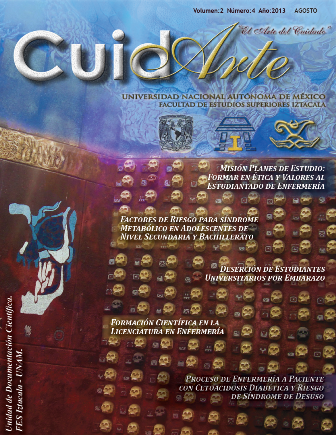Nursing process for patients with diabetic ketoacidosis and risk of disuse syndrome
Main Article Content
Abstract
This work is a PAE applied to the patient ADPG of the UCI of HGZ 24 using the Marjory Gordon’s 11 functional patterns model; assessment dated April 2, 2013 with a medical diagnosis of diabetic ketoacidosis, Diabetes Mellitus underlying pathology I, 17 years of evolution, currently treated with glargine insulin infusion. T / A 130/81 mmHg, HR 99/min., FR 26/min., SO2 100%. Temp. 37 ° C, capillary glucose 40 mg / dl at 0800 and 80 mg / dl at 10:00. Blood gas values pH 7.20, HCO3 19 mol / 1, PCO2 35 mmHg, PO2 66 mmHg. ADPG bedridden, under sedation with Propofol, Ramsay 4, and high risk of falls and pressure ulcers, immobile facial myoclonus and absence of eye reflexes, nasogastric feeding and drainage, attend ventilation control. Dry and pale skin, oral mucosa dehydrated, cleft lip, tongue ulceration distal portion due to the endotracheal tube. Right subclavian catheter, monitored by electrodes, edema in hands (+), hematoma index fingertip MSD. Underactive bowel, Foley transurethral catheter type, coccygeal ulcer stage II and stage MSPs calcaneal region II, presents myoclonus in limbs, arched feet left. Patient abandoned by primary caregiver. Was diagnosed with disuse syndrome risk, we identified the patient’s capability and elaborated a plan lasting four days, between interventions were executed bedridden patient cares, care of pressure ulcers mainly assessing our objective was met by 60 %.
Downloads
Download data is not yet available.
Article Details
How to Cite
Silva Monroy, G., & Altamirano Luna, J. S. (2013). Nursing process for patients with diabetic ketoacidosis and risk of disuse syndrome. CuidArte Journal, 2(4), 48–71. https://doi.org/10.22201/fesi.23958979e.2013.2.4.69072

